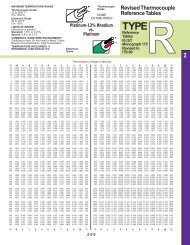Using Thermocouples
Using Thermocouples
Using Thermocouples
Create successful ePaper yourself
Turn your PDF publications into a flip-book with our unique Google optimized e-Paper software.
Documentation - It may seem incongruous to speak<br />
of documentation as being a source of voltage<br />
measurement error, but the fact is that thermocouple<br />
systems, by their very ease of use, invite a large number<br />
of data points. The sheer magnitude of the data can<br />
become quite unwieldy. When a large amount of data is<br />
taken, there is an increased probability of error due to<br />
mislabeling of lines, using the wrong NBS curve, etc.<br />
Since channel numbers invariably change, data<br />
should be categorized by measureand, not just channel<br />
number. 6 Information about any given measureand,<br />
such as transducer type, output voltage, typical value<br />
and location, can be maintained in a data file. This can<br />
be done under computer control or simply by filling out<br />
a pre-printed form. No matter how the data is<br />
maintained, the importance of a concise system should<br />
not be underestimated, especially at the outset of a<br />
complex data gathering project.<br />
Diagnostics<br />
Most of the sources of error that we have mentioned<br />
are aggravated by using the thermocouple near its<br />
temperature limits. These conditions will be<br />
encountered infrequently in most applications. But what<br />
about the situation where we are using small<br />
thermocouples in a harsh atmosphere at high<br />
temperatures? How can we tell when the thermocouple<br />
is producing erroneous results? We need to develop a<br />
reliable set of diagnostic procedures.<br />
Through the use of diagnostic techniques, R.P. Reed<br />
has developed an excellent system for detecting faulty<br />
thermocouples and data channels. 6 Three components<br />
of this system are the event record, the zone box test,<br />
and the thermocouple resistance history.<br />
Event Record - The first diagnostic is not a test at all,<br />
but a recording of all pertinent events that could even<br />
remotely affect the measurements. An example would be:<br />
MARCH 18 EVENT RECORD<br />
10:43 Power failure<br />
10:47 System power returned<br />
11:05 Changed M821 to type K thermocouple<br />
13:51 New data acquisition program<br />
16:07 M821 appears to be bad reading<br />
Figure 29<br />
We look at our program listing and find that measurand<br />
#M821 uses a type J thermocouple and that our new data<br />
acquisition program interprets it as a type J. But from the<br />
event record, apparently thermocouple M821 was<br />
changed to a type K, and the change was not entered into<br />
the program. While most anomalies are not discovered<br />
this easily, the event record can provide valuable insight<br />
into the reason for an unexplained change in a system<br />
measurement. This is especially true in a system<br />
configured to measure hundreds of data points.<br />
6 Refer to Bibliography 10<br />
Z-31<br />
Zone Box Test - A zone box is an isothermal terminal<br />
block of known temperature used in place of an ice bath<br />
reference. If we temporarily short-circuit the<br />
thermocouple directly at the zone box, the system<br />
should read a temperature very close to that of the zone<br />
box, i.e., close to room temperature.<br />
If the thermocouple lead resistance is much greater<br />
than the shunting resistance, the copper wire shunt<br />
forces V = 0. In the normal unshorted case, we want to<br />
measure T J , and the system reads:<br />
V ≅α(T J - T REF )<br />
But, for the functional test, we have shorted the terminals<br />
so that V=0. The indicated temperature T’ J is thus:<br />
0 = α (T’ J - T REF )<br />
T’ J = T REF<br />
Thus, for a dvm reading of V = 0, the system will<br />
indicate the zone box temperature. First we observe the<br />
temperature T J (forced to be different from T REF ), then<br />
we short the thermocouple with a copper wire and<br />
make sure that the system indicates the zone box<br />
temperature instead of T J .<br />
Cu<br />
+<br />
v<br />
–<br />
Cu<br />
Voltmeter<br />
Cu<br />
Cu<br />
T REF<br />
Copper Wire Short<br />
C<br />
Zone Box<br />
Isothermal Block<br />
SHORTING THE THERMOCOUPLE AT THE TERMINALS<br />
Figure 30<br />
This simple test verifies that the controller, scanner,<br />
voltmeter and zone box compensation are all operating<br />
correctly. In fact, this simple procedure tests everything<br />
but the thermocouple wire itself.<br />
Thermocouple Resistance - A sudden change in the<br />
resistance of a thermocouple circuit can act as a<br />
warning indicator. If we plot resistance vs. time for each<br />
set of thermocouple wires, we can immediately spot a<br />
sudden resistance change, which could be an indication<br />
of an open wire, a wire shorted due to insulation failure,<br />
changes due to vibration fatigue, or one of many failure<br />
mechanisms.<br />
For example, assume we have the thermocouple<br />
measurement shown in Figure 31.<br />
We want to measure the temperature profile of an<br />
underground seam of coal that has been ignited. The<br />
wire passes through a high temperature region, into a<br />
cooler region. Suddenly, the temperature we measure<br />
rises from 300°C to 1200°C. Has the burning section of<br />
the coal seam migrated to a different location, or has<br />
the thermocouple insulation failed, thus causing a short<br />
circuit between the two wires at the point of a hot spot?<br />
Fe<br />
T J














